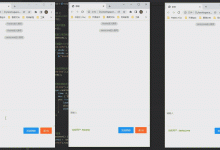/*
变量的使用
1.Java定义变量的格式:数据类型 变量名 = 变量值;
2.变量注意
Java中的每个变量都必须声明后使用
使用变量名来访问这块区域的数据
变量的作用域:其定义所在的一对{}内
变量只有在其作用域内才有效
同一个作用域内,不能定义重复的变量
java定义的数据类型
1.变量按照数据类型分:
基本数据类型:
整型:byte(1字节 = 8bit) / short(2字节) / int(4字节) /long(8字节)
byte (范围:-128 – 127)
浮点型:float 单精度 4字节 表示的范围比long还大/ double 双精度 8字节
字符型:char 定义时通常使用一对\’\’,内部只能有一个字符 或者 转义字符 /t /n
或者 直接用Unicode值来表示字符型常量 \’/u0043\’ = c
布尔型: boolean 只能取两个 值之一 true 和 false
条件判断 循环结构中使用
引用数据类型:
类(class)
接口(interface)
数组(array)
2.变量在类中声明的位置:
成员变量 vs 局部变量
*/
class VariableTest
{
public static void main(String[] args)
{
int myAge = 12;//变量的定义
//byte myS = 128; 超过 byte的定义范围
System.out.println(myAge);//变量的使用
int myNumber = 12456246;
System.out.println(myNumber);
long myNa = 54646654l;//long 类型 结尾必须加\”l\”或者\”L\”
System.out.println(myNa);
float aA = 123.4f;
System.out.println(aA);//float 后面要加”f“或者\”F\” 通常使用 double
}
}
//*******************************************************************************************************
/*
基本数据类型之间的运算规则:
前提:主要讨论7钟基本数据类型变量间的运算。不包含boolean类型
1.自动类型提升:
当容量小的数据类型的变量与容量大的数据类型的变量做运算时,结果自动提升为容量大的数据类型。
byte 、 char 、 short –>int –>long –>float –>double
特别的 当 byte char short 三种类型做运算时,结果为int型
2.强制类型转换:
自动类型提升运算的逆运算。
(1).需要使用强转符:()
(2).强转类型转换,可能导致精度损失
*/
class VariableTest1
{
public static void main(String[] args)
{
//精度损失案例1
double d1= 12.3;
int i1 = (int)d1;//截断操作
System.out.println(i1);
//没有精度损失
long l1 = 123;
short s2 = (short)l1;
System.out.println(s2);
//精度损失案例2
int i2 = 128;
byte b = (byte)i2;
System.out.println(b);//-128
}
}
//************************************************************************************************************************************
/*
String 类型变量的使用
1.String属于引用数据类型,翻译为:字符串
2.声明String类型变量时,使用一对\”\”
3.String可以和8种基本数据类型变量做计算,切运算只能是连接运算:+
4.运算的结果仍然是String类型
*/
class VariableTest2
{
public static void main(String[] args)
{
String s1 = \”Hello World\”;
System.out.println(\”s1\”);
String s2 = \”a\”;
String s3 = \”\”;
//char c = \’\’; 编译不通过 char 里必须有 字符或者 空格
//******************
int number = 1001;
String numberStr = \”学号:\”;
String info = numberStr + number;//+:连接运算
System.out.println(info);
//*****************
//练习1
char c = \’a\’;// a=97;A=65;
int num =10;
String str = \”hello\”;
System.out.println(c + num + str);//107hello
System.out.println(c + str + num);//ahello10
System.out.println(c + (num + str));//a10hello
System.out.println((c + num) + str);//107hello
System.out.println(num + str + c);//10helloa
//******************
//练习2
System.out.println(\”* *\”);//* *
System.out.println(\’*\’ + \’\\t\’ + \’*\’);//93
System.out.println(\’*\’ + \”\\t\” + \’*\’);//* *
System.out.println(\’*\’ + \’\\t\’ + \”*\”);//51*
System.out.println(\’*\’ + (\’\\t\’ + \”*\”));//**
//**************
//练习3
String str2 = 3.5f +\”\”;
//String str2 = 123;编译不通过,\”\”缺失
System.out.println(str2);
short s = 5;
s = (short)(s-2);
}
}
/*
判断是否能通过编译
1)short s = 5;
s = s – 2; //判断: 不行 2是int型 s是short 正确 s = (short)(s-2);
*/
//****************************************************************************************************************************************************
/*
计算机钟不同进制的使用说明
对于整数,有四种表示方式:
》二进制(binary): 0,1,满2进1,以0b或0B开头;
》十进制(decimal): 0-9 ,满10进1;
》八进制(octal): 0-7,满8进1,以数字0开头表示;
》十六进制(hex):0-9及A-F,满16进1,以0x或者0X开头表示。此处的A-F不区分大小写。
如 : 0x21AF +1 = 0X21B0
*/class BinaryTest {
public static void main(String[] args) {
int num1 = 0b110;
int num2 = 110;
int num3 = 0127;
int num4 = 0x110A;
System.out.println(\”num1 = \” + num1); // 6 2^2+2^1
System.out.println(\”num2 = \” + num2); //110 10^2+10^1
System.out.println(\”num3 = \” + num3); //87 1*8^2+2*8^1+7
System.out.println(\”num4 = \” + num4); //4362 16^3+16^2+10
}
}

 爱站程序员基地
爱站程序员基地


